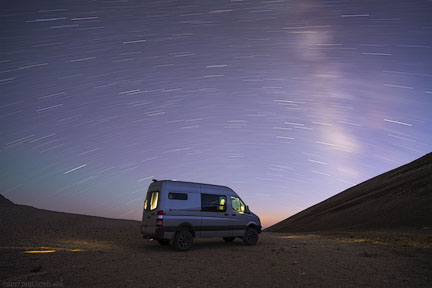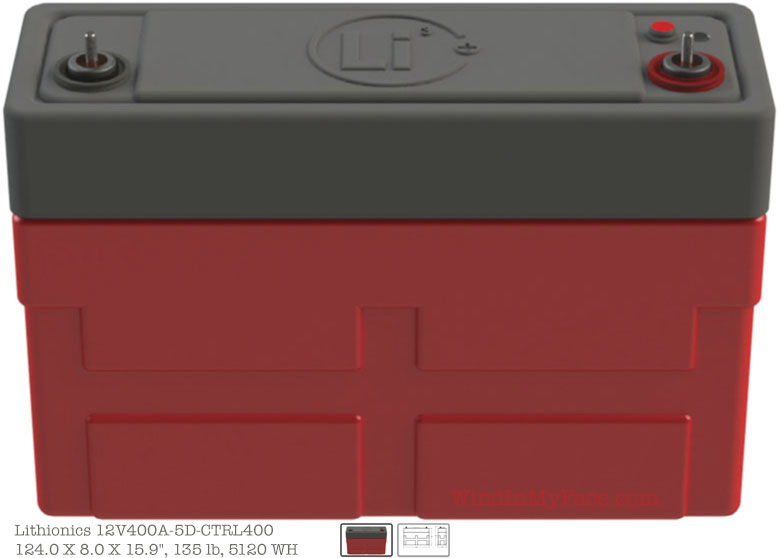RV Batteries: Lithium Batteries
Photographer and cyclist and Mac expert and software engineer Lloyd Chambers is available for consulting on general Sprinter considerations at his usual consulting rates via phone, or in person in the Palo Alto, CA area. Save yourself hours and mistakes by discussing issues up-front. More about Lloyd....
Get your batteries and alternator and regulator (the whole kit!) from NationsStarterAlternator.com.

Lithium RV batteries (specifically lithium ion iron phosphate) are an emerging technology for RV usage. With very high cycle counts, deep discharge capabilities and high recharge rates, they are ideal for many applications.
For my Sprinter van conversion, I chose the Lithionics lithium batteries; see the Batteries Overview page for why.
Real power capacity
The true power output of lithium batteries is substantially higher than lead acid for any type of duty cycle:
- Lithium batteries under load deliver about one more volt than lead acid. Since power in watts is V x A, this translates directly into about 8% more wattage for the same amperage.
- Lithium batteries provide extremely consistent voltage, dropping only 0.1 volts down to 80% discharge (at least with Lithionics). This keeps power output efficient and consistent, with the power converter able to do its job without getting upset over too-low voltage.
- 2000 to 3000 cyclels with 80% discharge is realistic, with is 3X to 5X more cycles than lead acid. Frequent 80% discharge instead of the life-prolonging 50% for lead acid means a far higher real capacity in practice—go longer, do more, recharge less often.
- On the negative side, lithium batteries might charge only to 90% of capacity via a vehicle alternator, due to insufficient voltage. It might be necessary to use solar or shore power or a generator to charge to 100% capacity.

5120 watt hours, 24.0 X 8.0 X 15.9, 135 pounds
Suppose one need 3000 watt hours of usable power: assuming 80% discharge for lithium, the battery would need to be at least 3750 watt hours—not that much higher than the nominal watt-hour rating.
For lead acid, assuming 50% discharge would mean at least 6000 watt hours. Moreover since the voltage drops with increasing discharge, the real capacity requirement may be quite a bit larger.
See RV Batteries: Depth of Discharge vs Cycle Count for how to think about depth of discharge versus cycle count and usage over time. Lead acid batteries discharged to 80% look much more viable than if held to 50% discharge, but 80% discharge comes at the cost of about 1/4 to 1/6 the cycle count. Still, the cycle count is effectively irrelevant for users not using the system every day of the year for years.
If one assumes that lead acid lifespan requires sticking to 50% discharge, then along with the voltage behavior the true requirement for lead acide versus lithium is at least 70% more watt hours to achieve the same usable power, and that’s a conservative estimate. In practice, it is probably more like 2X or greater based on real-world conditions.
Limitations under significant power draw
Voltage losses from cabling are a critical consideration. See Planning for Voltage Losses from Cabling and Battery.
Lithium batteries in sub-freezing temperatures
This was my #1 concern, since I regularly am high in the mountains where the outside air temperature can easily dip towards 20°F, and sometimes as low as 0°F. Moreover, under those conditions I not only want to use the batteries (space heater!) but to run the engine for a short while to keep them charged if possible.
I learned that while discharge is OK in sub-freezing temperatures, lithium batteries can be damaged by charging if the internal battery temperature is sub-freezing. Discharge will warm the battery, but how to know if it can be safely charged? That is, one might want a space heater or to use a microwave for hot water when cold, but I’d be idling the engine when it’s that cold—and I do not want to damage the batteries by so doing.
The good news is that there is an elegant solution to sub-freezing temperatures with lithium batteries: the Lithionics battery can be ordered with the internal temperature intervention sensor. This *internal* sensor prevents the battery from being charged when its internal temperature is too cold to charge, which would damage it. Other brands such as Ultimate Power have similar technology.



